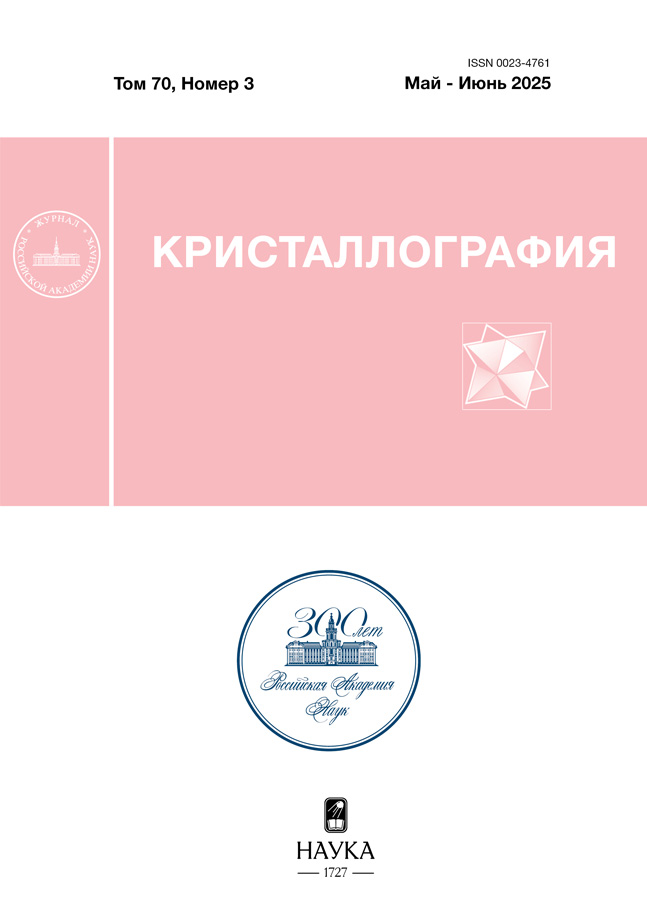Synthesis and crystal strucrure of Bis-(2,6-diaminopyridine) tetrachlorid zinc(II)
- Autores: Nazarov Y.E.1, Turaev X.X.1, Ashurov J.M.2, Kasimov S.A.1, Suyunov J.R.1, Ermuratova N.A.3, Kornilov K.N.4
-
Afiliações:
- Termez State University
- Institute of Bioorganic Chemistry of the Academy of Sciences of the Republic of Uzbekistan
- Termez Engineering and Technology Institute
- Russian Biotechnological University
- Edição: Volume 70, Nº 3 (2025)
- Páginas: 486-494
- Seção: STRUCTURE OF ORGANIC COMPOUNDS
- URL: https://rjonco.com/0023-4761/article/view/684972
- DOI: https://doi.org/10.31857/S0023476125030154
- EDN: https://elibrary.ru/BCSFJL
- ID: 684972
Citar
Texto integral
Resumo
In the presented work, the synthesis of a complex resulting from the reaction of 2,6-diaminopyridine with the Zn(II) ion in an alcohol solution of hydrochloric acid is described for the first time. The composition, molecular and crystal structure of the synthesized complex were determined by X-ray structural analysis. The structure of the new complex, its crystallographic data, and the geometry of hydrogen bonds in the crystal system were determined. The composition of the metal complex was confirmed by elemental analysis, and the existing chemical bonds were studied by IR spectroscopy. The surface of the crystals was studied according to Hirschfeld. To determine the stability of the obtained complex, its thermal analysis was carried out. The stability of the complex, caused by intramolecular hydrogen bonds, was confirmed.
Texto integral
Sobre autores
Y. Nazarov
Termez State University
Email: kornilovkn@mgupp.ru
Uzbequistão, Termez
X. Turaev
Termez State University
Email: kornilovkn@mgupp.ru
Uzbequistão, Termez
J. Ashurov
Institute of Bioorganic Chemistry of the Academy of Sciences of the Republic of Uzbekistan
Email: kornilovkn@mgupp.ru
Uzbequistão, Tashkent
Sh. Kasimov
Termez State University
Email: kornilovkn@mgupp.ru
Uzbequistão, Termez
J. Suyunov
Termez State University
Email: kornilovkn@mgupp.ru
Uzbequistão, Termez
N. Ermuratova
Termez Engineering and Technology Institute
Email: kornilovkn@mgupp.ru
Uzbequistão, Termez
K. Kornilov
Russian Biotechnological University
Autor responsável pela correspondência
Email: kornilovkn@mgupp.ru
Rússia, Moscow
Bibliografia
- Liu S.H., Chen J.-D., Liou L.-S., Wang J.-C. // Inorg. Chem. 2001. V. 40. № 25. P. 6499. https://doi.org/10.1021/ic010529c
- Moussa O.B., Chebbi H., Zid M.F. // J. Molec. Struct. 2019. V. 1180. P. 72. https://doi.org/10.1016/j.molstruc.2018.11.077
- Andreini C., Bertini I. // J. Inorg. Biochem. 2012. V. 111. P. 150. https://doi.org/10.1016/j.jinorgbio.2011.11.020
- Balan A.M., Ashoki R.F.N., Vasanthi M. et al. // Int. J. Life Sci. Pharm. Res. 2013. V. 3. № 2. P. 67. https://www.ijlpr.com/index.php/journal/article/view/376/278
- Crea F., De Stefano C., Milea D., Sammartano S. // J. Solution Chem. 2009. V. 38. P. 115. https://link.springer.com/article/10.1007/s10953-008-9357-0
- Cigala R.M., Crea F., De Stefano С. et al. // J. Mol. Liq. 2012. V. 165. P. 143. https://doi.org/10.1016/j.molliq.2011.11.002
- Cigala R.M., Crea F., De Stefano C. et al. // Monatch. Chem. 2015. V. 146. P. 527. https://doi.org/10.1007/s00706-014-1394-3
- Umirova G.A., Turaev Kh.Kh., Alimnazarov B.Kh. et al. // Acta Cryst. E. 2023. V. 79. № 9. P. 856. https://doi.org/10.1107/S2056989023007466
- Suyunov J.R., Turaev Kh.Kh., Alimnazarov B.Kh. et al. // IUCrData. 2023. V. 8. № 12. P. x231032. https://doi.org/10.1107/S2414314623010325
- Shoukry A.A., Al-Mhayawi S.R. // Eur. J. Chem. 2013. № 4. Р. 260. https://doi.org/10.5155/eurjchem.4.3.260-267.800
- Hall V.M., Bertke J.A., Swift J.A. // Acta Cryst. С. 2017. V. 73. № 11. P. 990. https://doi.org/10.1107/S2053229617014978
- Sakong C. // Dyes and Pigments. 2011. V. 88. № 2. P. 166. https://doi.org/10.1016/j.dyepig.2010.06.003
- Coelho P.J. // Dyes and Pigments. 2012. V. 92. № 1. P. 745. https://doi.org/10.1016/j.dyepig.2011.06.019
- Groom C.R. // Acta Cryst. B. 2016. V. 72. № 2. P. 171. https://doi.org/10.1107/S2052520616003954
- Raposo M.M. // Tetrahedron. 2011. V. 67. № 29. P. 5189. https://doi.org/10.1016/j.tet.2011.05.053
- Khanmohammadi H. // Dyes and Pigments. 2013. V. 98. № 3. P. 557. https://doi.org/10.1016/j.dyepig.2013.03.023
- Mahmoud W.H., Sayed F.N., Mohamed G.G. // Appl. Organometall. Chem. 2016. V. 30. № 11. P. 959. https://doi.org/10.1002/aoc.3529
- Merino E. // Chem. Soc. Rev. 2011. V. 40. № 7. P. 3835. https://doi.org/10.1039/C0CS00183J
- Rigaku Oxford Diffraction, CrysAlisPro Software System, Version 1.171.40.84a. 2020. Rigaku Corporation, Oxford, UK
- Sheldrick G.M. // Acta Cryst. А. 2015. V. 71. P. 3. https://doi.org/10.1107/S2053273314026370
- Sheldrick G.M. // Acta Cryst. C. 2015. V. 71. P. 3. https://dx.doi.org/10.1107/S2053229614024218
- Dolomanov O.V., Bourhis L.J., Gildea R.J. et al. // J. Appl. Cryst. 2009. V. 42. P. 339. https://dx.doi.org/10.1107/S0021889808042726
- Nazarov Y.E., Turaev Kh.Kh., Alimnazarov B.Kh. et al. // IUCrData. 2024. V. 9. № 6. Р. x240570. https://doi.org/10.1107/S2414314624005704
- Ben Moussa O., Chebbi H., Zid M.F. // Acta Cryst. E. 2018. V. 74. № 4. P. 436. https://doi.org/10.1107/S2056989018003171
- Suyunov J.R., Turaev Kh.Kh., Alimnazarov B.Kh. et al. // Acta Cryst. E. 2023. V. 79. P. 1083. https://doi.org/10.1107/S2056989023009350
- Mghandef M., Boughzala H. // Acta Cryst. E. 2015. V. 71. № 5. P. 555. https://doi.org/10.1107/S2056989015007707
- Nasr M.B., Soudani S., Lefebvre F. et al. // J. Mol. Struct. 2017. V. 138. P. 71. https://doi.org/10.1016/j.molstruc.2017.02.098
- Spackman P.R., Byrom P.J. // Chem. Phys. Lett. 1997. V. 267. № 3–4. Р. 215. https://doi.org/10.1016/S0009-2614(97)00100-0
Arquivos suplementares
















